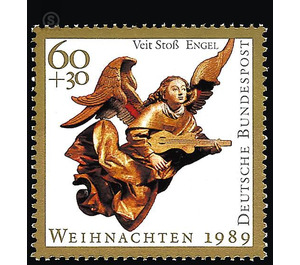Christmas - Germany / Federal Republic of Germany 1989 - 60 Pfennig
Theme: Art & Culture
| Country | Germany / Federal Republic of Germany |
| Issue Date | 1989 |
| Face Value | 60.00 |
| Color | brown |
| Perforation | K 13 3/4 |
| Printing Type | Six-color offset printing |
| Stamp Type | Postage stamp |
| Item Type | Stamp |
| Chronological Issue Number | 1315 |
| Chronological Chapter | GER-BRD |
| SID | 296686 |
| In 36 Wishlists | |
The Deutsche Bundespost publishes the Christmas stamps in favor of the Free Welfare. The recipient of the proceeds from the sale of these special stamps is the "Bundesarbeitsgemeinschaft der Freien Wohlfahrtspflege eV", which includes Arbeiterwohlfahrt, the Diakonische Werk of the EKD, the German Caritas Association, the German Paritätische Wohlfahrtsverband, the German Red Cross and the Central Welfare Office of the Jews in Germany have joined together. These organizations help wherever government aid is not enough. On October 2, 1979, the city leaders of Krakow and Nuremberg signed a treaty that sealed the partnership between the two cities. Since then, this relationship has developed into one of the most intense and flourishing, if not the most important, of the not-so-numerous German-Polish twinnings, incidentally. In the spring of 1989, about ten years later, the parish of the Krakow Marienkirche and beyond the whole city celebrated the 500th anniversary of the Marian altar, probably the largest Gothic carved altar, which the artist Veit Stoß had completed in 1489. The two events have more to do with each other than superficially. For the sculptor Veit Stoß, who was most likely born in Horb am Neckar, had come to Nuremberg in 1473, but gave up his local civil rights there in 1477 in order to move with his family to Krakow, where he had been commissioned by the parish of St. Mary's Church for the enormous work of art. His art brought him to Krakow and all Poland to the highest honors; Kings and bishops gave him important orders. Nevertheless, he decided to return to Nuremberg in 1496. The reasons are not completely clear, but it is believed that his seriously ill wife Barbara wanted to return home. She died shortly after arriving in Nuremberg. At that time there were extensive, centuries-long cultural and economic links between Krakow and Nuremberg. Veit Stoß was only one of the many who worked as merchants, artists, and artisans for both cities, but he was - in retrospect - the most prominent. Germans and Poles soon quarreled over the "claims to possession" of him, a dispute that was ultimately resolved only nowadays; The twinning has done its part. Now Nuremberg and Krakow speak of him as a "citizen of both cities," they even see him as a "patron" of their friendship, he belonged to no one and all, Europe and the world. The life of Veit Stoß is glittering with glory and shadowed by tragedy. A few years after his return to the Free Imperial City of Nuremberg, he gets involved in speculative money transactions and is cheated. In order to get his way, he falsifies a document and is condemned after a long, dramatic trial. He escapes the death penalty only through the intercession of influential personalities. He is "branded," d. H. Both cheeks are drawn publicly by the hangman with the branding iron. From then on, he has long been a "dishonest", but also a "crazy and shrewd man" who is difficult to deal with. The Tucher family, one of the first of the city, is the one who years later takes courageous confidence in him. In 1517 Anton II Tucher awarded him a major contract. It is the "English greeting" (angel's greeting) for the St. Lawrence Church, next to the Krakow Marian altar probably the most significant work of the master. He has taken the motifs for the special postage stamp "Christmas 1989". The piece of art, carved from limewood, hanging freely in the church, represents the Annunciation scene. The two larger-than-life figures of the Virgin Mary and the Archangel Gabriel are in the center. Goddess is enthroned in - one might say - "imperial majesty." The scene is framed by a wreath of five by ten roses, interspersed with five medallions depicting scenes from the life of Jesus and Mary, essentially the "joyful rosary" from the Marian prayer tradition. Two other medallions show the death of Mary (the main theme of the Cracow Marian altar!) And the admission of Mary to heaven. Jubilant and musical angels hover around the moving image. The rosary depictions depict the episodes of Nativity, Adoration of the Magi, the Resurrection of Christ, the Ascension, and the outpouring of the Holy Spirit. Veit Stoß died in Nuremberg in 1533 at the age of more than 80 years. His last great work, a Marian altar for the monastery church of the Carmelites in Nuremberg, fell into the confusion of the Reformation. The heirs sold the altar ten years after the death of the master to Bamberg. There he is today in the cathedral to see.


